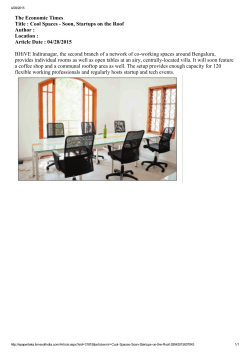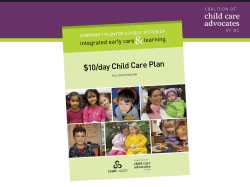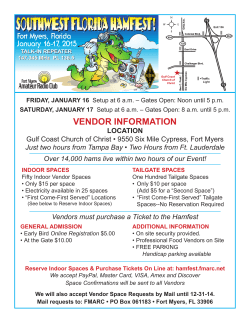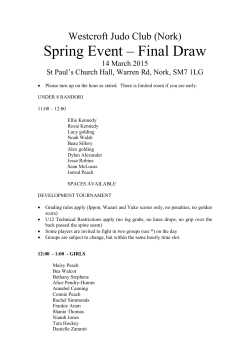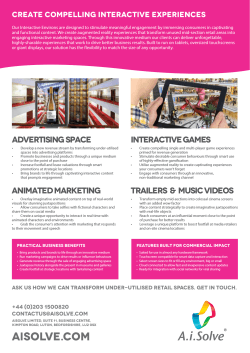
Torin Monahan â Flexible Space and Built Pedagogy: Emerging IT
Torin Monahan – Flexible Space and Built Pedagogy: Emerging IT Embodiments (2002) “I assume that built environments afford conditions of practice by their very design, and that these affordances embody political values that translate into learning activities.” (pg. 1) Flexibility – movable furniture, re-configurable rooms, passageways Flexibility also encompasses building in a way that embraces the unforeseen future Monahan breaks flexibility down into 5 elements – fluidity (designing space so individuals, sightlines, sound, light and air are considered); versatility (multiple use space); convertibility (how easily can the space be repurposed); scalability (can the space be expanded or made smaller); modifiability (does the design invite the use to reconfigure the space – make it their own?) Need to consider that space is both physical and virtual – Physical space -- I can move through the room and you can still see me and interact with me Virtual space – Body is in a physical space while the mind is in a virtual place (physical concerns and virtual concerns) single focus cameras that do not pick up everyone in the space – can be seen? You are not in class. Policies of using the space can discourage the use of space “Educational architecture literature grounds itself in a conviction that the design of built spaces influences the behaviors and actions of individuals within those spaces. To a certain extent, these spaces embody the pedagogical philosophies of their designers” (p. 5) Building flexible space requires more energy to be focused on the type of activities and use of technological activities that occur within a space Build for learning activities that incorporate technology Concept of “sociality” – “recognizes that identity construction is inseparable from the relationship between individuals, spaces and practices.” (p. 7) Nancy Van Note Chism “Challenging traditional assumptions and rethinking learning spaces” in Educause Learning Spaces (2006). “We can facilitate deeper and richer learning when we design spaces with learning in mind.” (pg. 2.1) Individuals are constantly learning no where they are located – they are learning through experiences and reflection The pursuit of learning is changing – more emphasis on interaction, team work, practical experience (hands-on), developing thinking abilities Moving away from the notion that learning occurs only in specific space, at a specific time – there is always a front of the room, that learning is a quiet, individual effort – the ability to hear and see is only a concern in a large lecture halls Learning theory – “active construction of knowledge by the learner.” “Environments that provide experience, stimulates the senses, encourage the exchange of information, and offer opportunities for rehearsal, feedback, application, and transfer are most likely to support learning.” (p. 2.4) Characteristics of the learners are changing More culturally diverse Mix of age and experiences Higher percentage of taking courses and working So the design of the learning spaces need to change to accommodate current perceptions of learning (social and experiential) and our students Space for groups Technology to screen share Table tops/desk tops with room for technology and learning materials. Van Note Chism’s space elements: Flexibility: ability to move seamlessly from one type of learning activity to another (small group work to large group discussion) Comfort: Is the seating comfortable, work surface is appropriately sized for mobile devices plus learning materials Sensory stimulation: Is the spaces’ ambiance inviting to the individual Technology support: Enough wireless connections, enough electrical outlets or portable power devices, display systems for screen sharing Decenteredness: There is no front to the room, the space invites all individuals to participate in the learning activity Studio classroom: Flexible furniture, integrated technology, availability to higher end technology for everyone, facilitation of group work Information Commons/Collaboratory: Spaces, often in libraries, that support group work Living-learning spaces: Integrating classes into the residence hall Corridor niches: Designing hallways to encourage studying and meeting space – accidental learning space Graves and Berg (2009). 5.5 Support Teaching and Learning through the Intelligent Design of Learning Support Spaces: A Griffith University Example. 5.5 Learning Spaces in Higher Education: Positive Outcomes by Design. Graves and Berg Principles for the environment: Create spaces that can be used in multiple ways (either singular or in conjunction with other activities) Maximize the flexibility of the space Use vertical space as well as horizontal Integration of functions which where separate previously Maximize both teacher and student control of the space Develop space that allows for a diverse set of activities to occur in the space Access, use and ownership of space maximized for the student (all pg. 67) To meet the changes in pedagogy, changes must happen in the design of space Refers to Lomas & Oblinger (2006) student characteristics [digital, mobile, independent, social and participatory] Questions to think about What happens here? How is the space used? Elements to include: Natural light Bring outdoors indoors Activity zones Use design to declare the appropriate behavior for the space Use color, textures, materials, objects to create the ambiance of the space Flexibility Technology support – wireless access, electricity, writing surfaces, screen sharing systems JISC Designing Spaces for Effective Learning: A guide to 21st century learning space design (2006) “A learning space should be able to motivate learners and promote learning as an activity, support collaborative as well as formal practice, provide personalized and inclusive environment, and be flexible in the face of changing needs.” Motivational effect of spaces with natural light, easy and comfortable to move in Collaboration is encouraged – learning through social interaction Personalisation and inclusion – technology as an enabler rather than a gate keeper Pedagogy first – “The prevailing pedagogic approach has swung towards active and collaborative learning, but room design and staff skill sets do not always reflect this.” Future proofing -- ensure design can accommodate change Tools fit for purpose – The use of technology does not mean “effective teaching or learning” but can help the teaching and learning
© Copyright 2025
